What Is Considered Inappropriate for a Wedding? Tips to Avoid Faux Pas
Attending a wedding is an exciting occasion, but knowing what to wear can be a bit tricky. Inappropriate guest attire often stands out for all the wrong reasons, distracting from the celebration. Understanding wedding etiquette is crucial for ensuring you blend in smoothly with other guests and respect the bride and groom’s special day.

Generally, avoid wearing white as this is traditionally reserved for the bride. Even though fashion rules have relaxed over the years, it’s best to steer clear of excessively bold choices, like bright red, sequins, or animal prints. These can draw unwanted attention and shift focus away from the couple. The goal is to dress stylishly yet subtly.
Consider the dress code specified on the wedding invitation. Whether it’s cocktail attire or formal wear, sticking to the guidelines helps you fit in and show respect. If the invitation doesn’t specify a dress code, a good rule of thumb is dressing elegantly but not overly flashy, avoiding casual fabrics like denim or chino for more formal settings. For more detailed guidance on attire, including what to absolutely avoid, check out this helpful resource.
Understanding Wedding Dress Codes
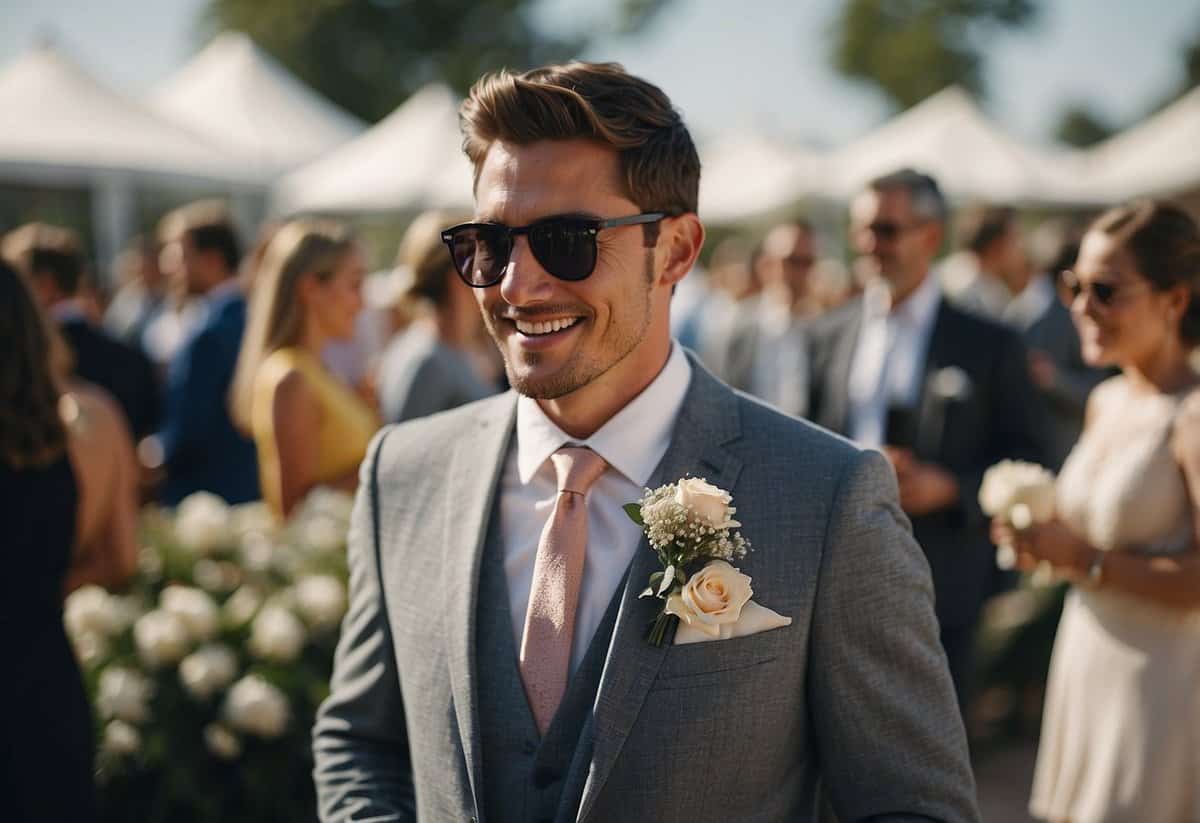
Wedding attire can vary greatly depending on the dress code specified by the couple. Knowing what to wear is key to fitting in and feeling comfortable while also respecting the event’s formality and cultural significance.
Formal Attire Explained
For formal weddings, a black-tie or black-tie optional dress code is common. This means that for men, a black tux with a white dress shirt and black bow tie is appropriate. Women should wear long gowns or sophisticated cocktail dresses. If you want to make a statement, keep it elegant with classy accessories and heels. Black-tie events usually start in the evening, so plan your outfit with that in mind.
Formal attire aims to create a polished and sophisticated atmosphere. It’s essential to adhere closely to the guidelines to avoid feeling out of place. Formal jumpsuits for women and dark suits for men can add a modern twist while staying within the dress code.
Casual Dress Code Considerations
Casual dress codes offer more flexibility. Think business casual or smart casual. Men can opt for dress slacks and button-up shirts without needing a tie. Women can wear sundresses, skirts, and nice blouses. Footwear should still be neat; avoid sneakers or overly casual sandals.
This kind of wedding is often held outdoors or during the daytime. The key is to maintain a neat appearance without being overly formal. It’s a good idea to check if there’s a theme or color scheme to match your outfit accordingly.
Cultural Attire and Significance
Cultural weddings, such as Indian or Chinese weddings, often have specific dress codes related to tradition. For Indian weddings, men may wear a kurta or sherwani, while women typically wear sarees or lehengas decorated with intricate designs. These outfits are not just about appearance but symbolize cultural heritage and respect for traditions.
Chinese weddings might involve wearing qipaos or traditional dresses for women, and changshans for men. Colors often hold cultural significance; for example, red is a symbol of good luck in Chinese culture. Always be respectful of the requested attire and understand its cultural importance to avoid offending the hosts.
Following these guidelines will help you enjoy the wedding and show respect to the couple’s wishes.
Colors and Patterns to Avoid
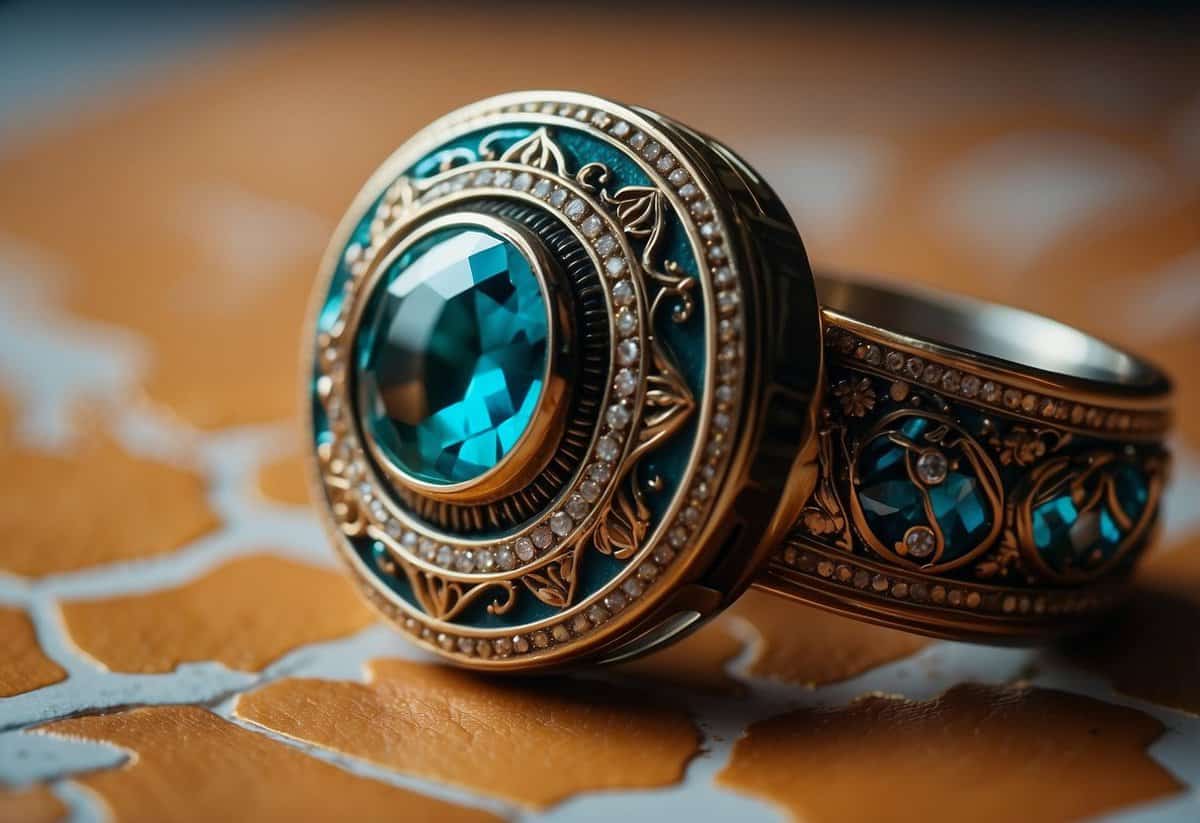
When attending a wedding, it’s important to choose your attire carefully to show respect for the couple. Certain colors and patterns can be deemed inappropriate and might offend the nearlyweds and their guests.
Traditional Taboos and Modern Trends
You should definitely avoid wearing white and ivory. These colors are traditionally reserved for the bride, and wearing them can steal the spotlight.
Cream, off-white, and champagne are also off-limits since they are too close to white. When in doubt, steer clear of any hue that could be mistaken for the bride’s dress.
Red is another tricky color. It can draw a lot of attention and might be seen as too bold for the occasion.
Black, traditionally associated with mourning, used to be frowned upon. But recently, it’s become more acceptable at weddings, especially for evening events. Just ensure your black dress feels celebratory rather than somber.
Making Sense of Color Etiquette
While neon colors are fun, they can be too eye-catching and are best avoided at weddings. Such bright colors can distract from the main event.
When it comes to patterns, avoid anything with a base that is close to white or ivory, such as florals with a prominent white background. Patterns should not overshadow the bridal party.
Also, avoid patterns that blend with the wedding colors, especially if the theme is known. Compliment, but don’t coordinate exactly with the bridal party.
Being mindful of these guidelines ensures you look great while respecting the couple’s big day. For more advice on what not to wear, check out this guide on Wedding Guest Etiquette.
Appropriate Attire for Different Times and Locations
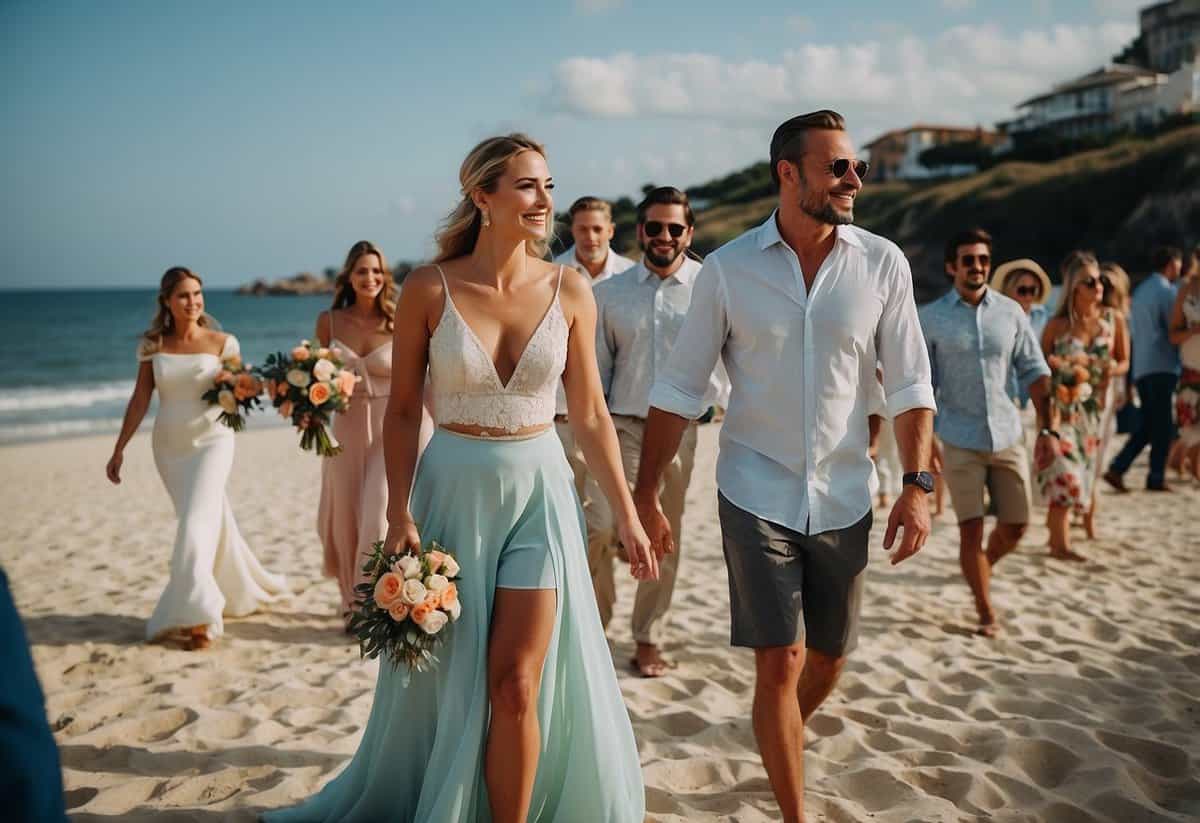
Choosing the right outfit for a wedding depends on several factors, including the time of day and the location. Understanding these factors will help you dress appropriately and respect the event.
Daytime vs. Evening Attire
For daytime weddings, lighter colors and fabrics are a good choice. Men can wear suits in shades like light gray or blue, while women might opt for a summer dress or a knee-length skirt and blouse. Avoid anything too flashy or formal.
In contrast, evening weddings call for more formal attire. Men usually wear dark suits or tuxedos, and women can choose elegant dresses or gowns. Evening attire tends to be richer in color and material, such as blacks, navy blues, and jewel tones.
Indoor vs. Outdoor Wedding Considerations
Indoor weddings, such as those held in a ballroom or church, generally have a formal dress code. Men should stick to tailored suits, and women can wear cocktail dresses or long gowns. The environment is controlled, so comfort is less of an issue.
Outdoor weddings, like those on a beach or in a garden, allow for a more relaxed dress code. Think about the weather and terrain. For a beach wedding, a sundress and sandals might be perfect. For a garden party, go for a breezy dress and practical footwear that won’t sink into the grass.
Geographical Etiquette
The location of the wedding can also influence what you should wear. In some places, like the South, traditional styles and colors might be expected. In contrast, a wedding in a city like New York might call for a more fashion-forward approach.
In tropical locations, lightweight fabrics and bright colors are fitting. Conversely, in colder climates, layering and warmer materials are key. Always consider local customs and dress codes to ensure your attire is appropriate for the region.
Making sure you’re dressed correctly for the time, location, and type of wedding shows respect for the couple and helps you feel confident and comfortable.
Clothing Items to Exclude
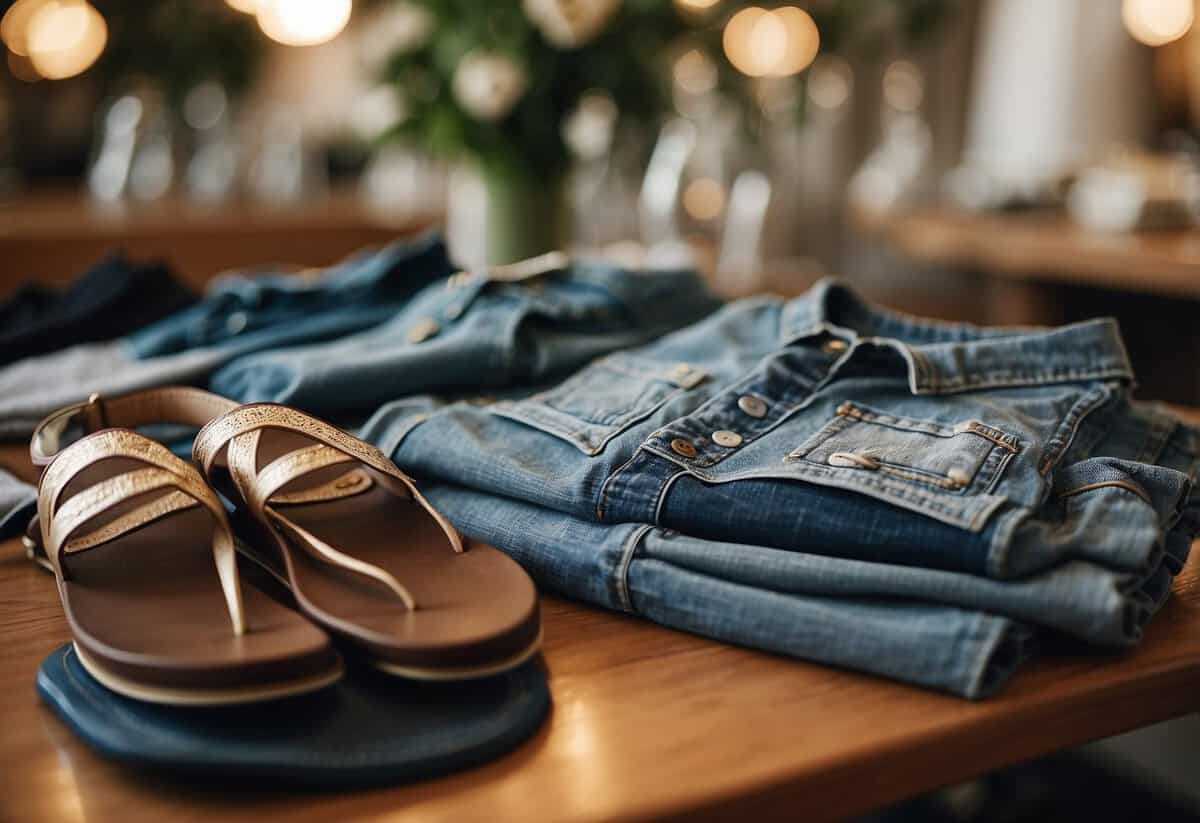
When attending a wedding, it is important to avoid certain clothing items that might not fit the event’s formality. Pay attention to inappropriate apparel, footwear choices, and accessories to ensure you respect the occasion and the couple.
Unsuitable Apparel Choices
Avoid wearing denim and shorts to any wedding, regardless of how casual it may seem. Denim is often too informal, and shorts are never appropriate, even in a relaxed setting. Instead, opt for khakis or chinos if the dress code feels more laid-back. Skimpy outfits and overly casual clothing, such as t-shirts or athleisure wear, should also be left at home.
For formal weddings, long dresses are typically expected for women. Consider classic evening gowns instead of the dress you wore to prom. Men should avoid wearing just a blazer and jeans. Stick to full suits or tuxedos to match the event’s formality.
Footwear Faux Pas
While choosing footwear, it’s crucial to balance style with the occasion. Leave your sneakers, flip-flops, and overly casual shoes at home. These items are often too informal and can look out of place. Opt instead for polished dress shoes or elegant flats.
Women should avoid overly high heels if they are not used to wearing them, as comfort throughout the event is key. Similarly, men should ensure their shoes match their suit or tuxedo in style and elegance.
Accessorizing Appropriately
Accessories can make or break an outfit, so choose wisely. Distracting items such as bold patterns, neon colors, and over-the-top sequins should be avoided as they can draw attention away from the couple. Hats should be chosen carefully; fascinators can work well with gowns, but cowboy hats are usually suitable only for Western-themed weddings.
Jewelry should be tasteful and not overpowering. Large, show-stealing pieces that attract too much attention are best left at home. Simple and elegant accessories can complement your outfit without dominating your look or outshining the bride and groom.
By paying attention to these tips, you will show respect for the couple and blend seamlessly into the joyous celebration.
Special Considerations for Wedding Party Members
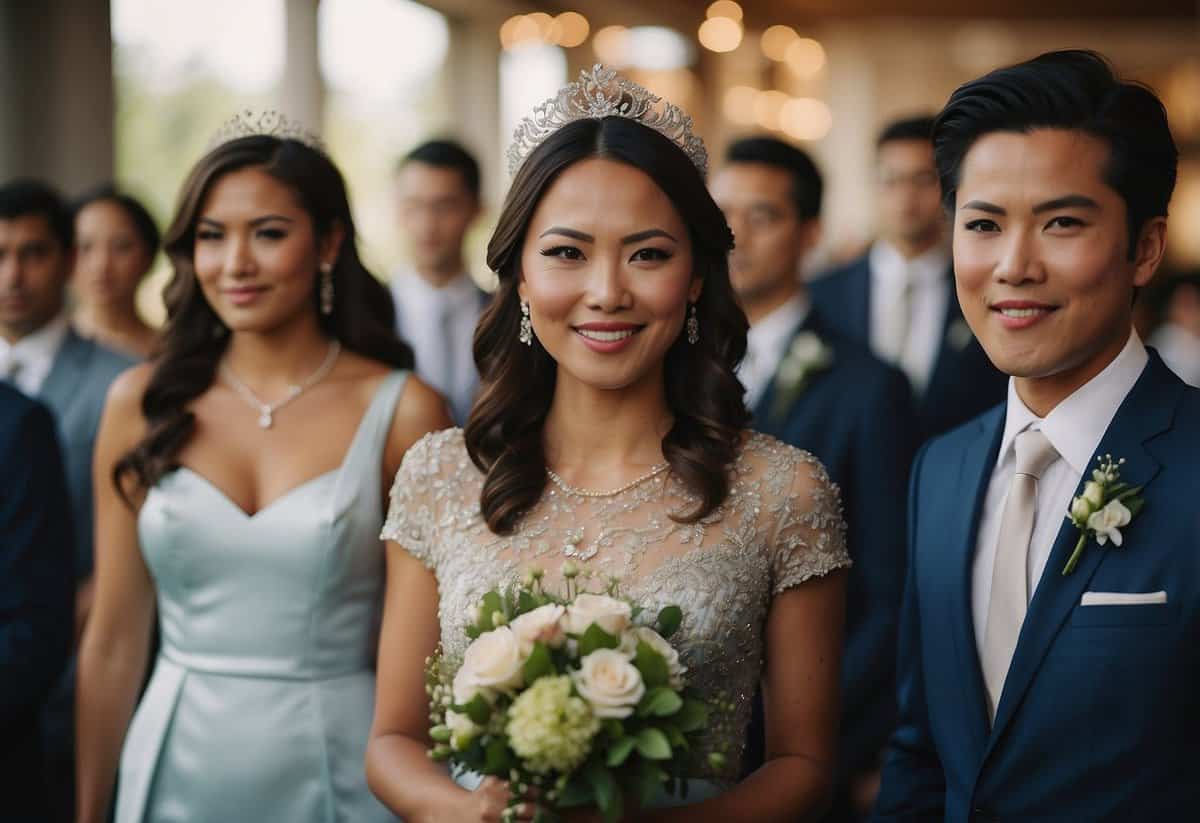
As a member of the wedding party, your role comes with specific expectations. You’ll need to be mindful of your attire and behavior to ensure everything goes smoothly.
Bridesmaid and Groomsman Guidelines
If you’re a bridesmaid or groomsman, it’s crucial to follow the dress code set by the bride and groom. Clothing should be formal and match the chosen colors like black or royal blue.
For bridesmaids, this might mean wearing dresses that respect certain guidelines. Avoid overly revealing necklines or exposed shoulders unless approved. Pay attention to details like sparkles and sequins, keeping them subtle to not overshadow the bride.
Groomsmen should adhere to the same level of formality. Your role might also include duties like organizing bachelor or bachelorette parties, so coordinate with the other members to make sure everything goes as planned.
Dressing as a Close Relative
Close relatives, such as the bride’s or groom’s parents, have unique dressing considerations. Fathers often wear suits consistent with the groomsmen, often in black or matching royal blue hues. Mothers should choose elegant dresses, avoiding shades that clash with the wedding colors.
When it comes to style, mothers need to pay attention to the level of formality. It’s best to avoid plunging necklines and overly flashy sequins, keeping the focus on the bridal party. A tasteful dress with modest sparkles is a great choice.
Remember, your attire should complement, not compete with, the wedding party, ensuring a harmonious look in photos and during the ceremony.



